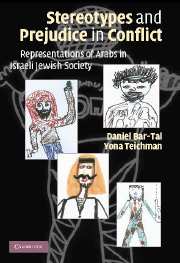Book contents
- Frontmatter
- Contents
- List of Tables
- List of Drawings
- List of Figures
- Preface
- Stereotypes and Prejudice in Conflict
- Introduction
- 1 The Psychological Basis of Intergroup Relations
- 2 Psychological Intergroup Repertoire in Intractable Conflicts
- 3 The Context: The Arab-Israeli Intractable Conflict
- 4 Representation of Arabs in Public Discourse
- 5 Representation of Arabs in School Textbooks
- 6 Representation of Arabs in Cultural Products
- 7 Representation of Arabs by Israeli Jews: Review of Empirical Research
- 8 The Development of Shared Psychological Intergroup Repertoire in a Conflict: Theory and Methods
- 9 Studies with Preschoolers
- 10 Studies with Schoolchildren, Adolescents, and Young Adults
- 11 The Reflection of Social Images in Human Figure Drawing
- 12 Conclusions and Implications
- References
- Index
- References
References
Published online by Cambridge University Press: 24 July 2009
- Frontmatter
- Contents
- List of Tables
- List of Drawings
- List of Figures
- Preface
- Stereotypes and Prejudice in Conflict
- Introduction
- 1 The Psychological Basis of Intergroup Relations
- 2 Psychological Intergroup Repertoire in Intractable Conflicts
- 3 The Context: The Arab-Israeli Intractable Conflict
- 4 Representation of Arabs in Public Discourse
- 5 Representation of Arabs in School Textbooks
- 6 Representation of Arabs in Cultural Products
- 7 Representation of Arabs by Israeli Jews: Review of Empirical Research
- 8 The Development of Shared Psychological Intergroup Repertoire in a Conflict: Theory and Methods
- 9 Studies with Preschoolers
- 10 Studies with Schoolchildren, Adolescents, and Young Adults
- 11 The Reflection of Social Images in Human Figure Drawing
- 12 Conclusions and Implications
- References
- Index
- References
- Type
- Chapter
- Information
- Stereotypes and Prejudice in ConflictRepresentations of Arabs in Israeli Jewish Society, pp. 409 - 456Publisher: Cambridge University PressPrint publication year: 2005



